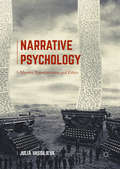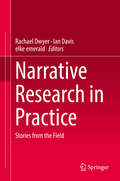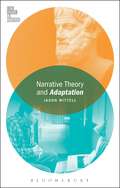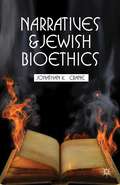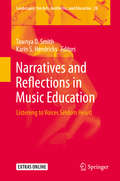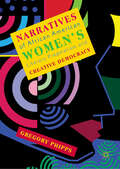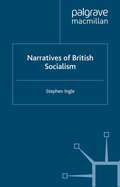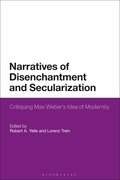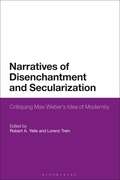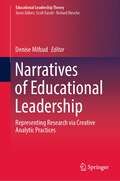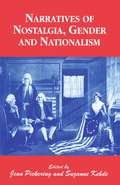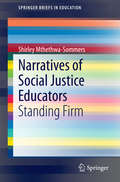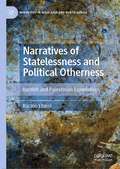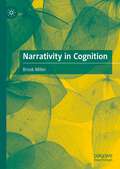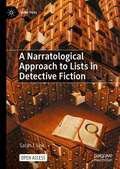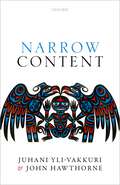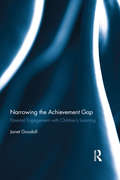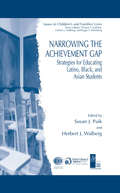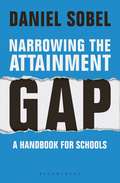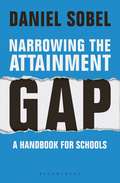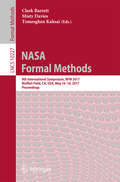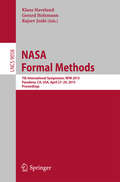- Table View
- List View
Narrative Psychology: Identity, Transformation and Ethics
by Julia VassilievaThis book provides the first comparative analysis of the three major streams of contemporary narrative psychology as they have been developed in North America, Europe, and Australia and New Zealand. Interrogating the historical and cultural conditions in which this important movement in psychology has emerged, the book presents clear, well-structured comparisons and critique of the key theories of narrative psychology pioneered across the globe. Examples include Dan McAdams in the US and his followers, who have developed a distinctive approach to self and identity as a life story over the past two decades; in the Netherlands by Hubert Hermans, whose research on the ‘dialogical self’ has made the University of Nijmegen a centre of narrative psychological research in Europe; and in Australia and New Zealand, where the collaborative efforts of Michael White and David Epston helped to launch the narrative movement in psychotherapy in the late 1980s.
Narrative Research in Practice: Stories from the Field
by Rachael Dwyer Ian Davis Elke EmeraldThis book directly addresses the multiplicity and complexity of narrative research by illustrating a variety of avenues to pursuing and publishing research that falls under the umbrella of narrative work. The chapters are drawn from a wide range of disciplines including education, literary studies, cultural studies, music and clinical studies. Each chapter considers a particular methodological issue or approach, illustrating how it was addressed in the course of the research. Each of the chapters concludes with a set of discussion exercises and a further reading list. The book offers a valuable resource for established researchers seeking to expand their methodological and theoretical repertoire, and for graduate students and researchers new to narrative methods.
Narrative Theory and Adaptation. (Film Theory in Practice)
by Jason MittellNarrative Theory and Adaptation offers a concise introduction to narrative theory in jargon-free language and shows how this theory can be deployed to interpret Spike Jonze's critically acclaimed 2002 film Adaptation. Understanding narrative theory is crucial to make sense of the award-winning film Adaptation. The book explicates, in clear prose for beginners, four key facets important to the narrative theory of film: the distinction between practical vs. critical theory, the role of adaptation, the process of narrative comprehension, and notions of authorship. It then works to unlock Adaptation using these four keys in succession, considering how the film demands a theoretical understanding of the storytelling process. In using this unusual case study of a film, the author makes the case for the importance of narrative theory as a general perspective for filmmakers, critics, and viewers alike.
Narrative Theory and Adaptation. (Film Theory in Practice)
by Jason MittellNarrative Theory and Adaptation offers a concise introduction to narrative theory in jargon-free language and shows how this theory can be deployed to interpret Spike Jonze's critically acclaimed 2002 film Adaptation. Understanding narrative theory is crucial to make sense of the award-winning film Adaptation. The book explicates, in clear prose for beginners, four key facets important to the narrative theory of film: the distinction between practical vs. critical theory, the role of adaptation, the process of narrative comprehension, and notions of authorship. It then works to unlock Adaptation using these four keys in succession, considering how the film demands a theoretical understanding of the storytelling process. In using this unusual case study of a film, the author makes the case for the importance of narrative theory as a general perspective for filmmakers, critics, and viewers alike.
Narratives and Jewish Bioethics (Content and Context in Theological Ethics)
by J. CraneNarratives and Jewish Bioethics searches for answers to the critical question of what roles ancient narratives play in creating modern norms by Jewish bioethicists utilizing the Jewish textual tradition.
Narratives and Reflections in Music Education: Listening to Voices Seldom Heard (Landscapes: the Arts, Aesthetics, and Education #28)
by Tawnya D. Smith Karin S. HendricksThis volume offers chapters written by some of the most respected narrative and qualitative inquiry writers in the field of music education. The authorship and scope are international, and the chapters advance the philosophical, theoretical, and methodological bases of narrative inquiry in music education and the arts. The book contains two sections, each with a specific aim. The first is to continue and expand upon dialogue regarding narrative inquiry in music education, emphasizing how narrative involves the art of listening to and hearing others whose voices are often unheard. The chapters invite music teachers and scholars to experience and confront music education stories from multiple perspectives and worldviews, inviting an international readership to engage in critical dialogue with and about marginalized voices in music. The second section focuses on ways in which narrative might be represented beyond the printed page, such as with music, film, photography, and performative pieces. This section includes philosophical discussions about arts-based and aesthetic inquiry, as well as examples of such work.
Narratives of African American Women's Literary Pragmatism and Creative Democracy
by Gregory PhippsThis book charts an interdisciplinary narrative of literary pragmatism and creative democracy across the writings of African American women, from the works of nineteenth-century philosophers to the novels and short stories of Harlem Renaissance authors. The book argues that this critically neglected narrative forms a genealogy of black feminist intersectionality and a major contribution to the development of American pragmatism. Bringing together the philosophical writings of Maria Stewart, Anna Julia Cooper, and Mary Church Terrell and the fictional works of Jessie Fauset, Nella Larsen, and Zora Neale Hurston, this text provides a literary pragmatist study of the archetypes, tropes, settings, and modes of resistance that populate the narrative of creative democracy. Above all, this book considers how these philosophers and authors construct democracy as a lived experience that gains meaning not through state institutions but through communities founded on relationships among black women and their shared understandings of culture, knowledge, experience, and rebellion.
Narratives of British Socialism
by S. IngleWhat can the study of narratives bring to our understanding of political ideas that other forms of analysis cannot? In Narratives of British Socialism , Stephen Ingle shows how imaginative literature can be used to give definition to political thought. The origins, development and eventual decline of British socialism are analyzed in the writings of Morris, Shaw, Wells, Huxley, Koestler, Orwell and others. Ingle concludes that narratives can give us an experiential understanding of political ideas.
Narratives of Disenchantment and Secularization: Critiquing Max Weber’s Idea of Modernity
by Robert A. Yelle and Lorenz TreinWhat does it really mean to be modern?The contributors to this collection offer critical attempts both to re-read Max Weber's historical idea of disenchantment and to develop further his understanding of what the contested relationship between modernity and religion represents. The approach is distinctive because it focuses on disenchantment as key to understanding those aspects of modern society and culture that Weber diagnosed. This is in opposition to approaches that focus on secularization, narrowly construed as the rise of secularism or the divide between religion and politics, and that then conflate this with modernization as a whole.Other novel contributions are discussions of temporality - meaning the sense of time or of historical change that posits a separation between an ostensibly secular modernity and its religious past - and of the manner in which such a sense of time is constructed and disseminated through narratives that themselves may resemble religious myths. It reflects the idea that disenchantment is a narrative with either Enlightenment, Romantic, or Christian roots, thereby developing a conversation between critical studies in the field of secularism (such as those of Talal Asad and Gil Anidjar) and conceptual history approaches to secularization and modernity (such as those of Karl Löwith and Reinhart Koselleck), and in the process creates something that is more than merely the sum of its parts.
Narratives of Disenchantment and Secularization: Critiquing Max Weber’s Idea of Modernity
What does it really mean to be modern?The contributors to this collection offer critical attempts both to re-read Max Weber's historical idea of disenchantment and to develop further his understanding of what the contested relationship between modernity and religion represents. The approach is distinctive because it focuses on disenchantment as key to understanding those aspects of modern society and culture that Weber diagnosed. This is in opposition to approaches that focus on secularization, narrowly construed as the rise of secularism or the divide between religion and politics, and that then conflate this with modernization as a whole.Other novel contributions are discussions of temporality - meaning the sense of time or of historical change that posits a separation between an ostensibly secular modernity and its religious past - and of the manner in which such a sense of time is constructed and disseminated through narratives that themselves may resemble religious myths. It reflects the idea that disenchantment is a narrative with either Enlightenment, Romantic, or Christian roots, thereby developing a conversation between critical studies in the field of secularism (such as those of Talal Asad and Gil Anidjar) and conceptual history approaches to secularization and modernity (such as those of Karl Löwith and Reinhart Koselleck), and in the process creates something that is more than merely the sum of its parts.
Narratives of Educational Leadership: Representing Research via Creative Analytic Practices (Educational Leadership Theory)
by Denise MifsudThis book documents and deconstructs the concept of educational leadership within various education settings originating from diverse global environments. It focuses on presenting different readings of educational leadership via distinct theoretical and methodological applications. It takes forward the idea of critical leadership studies and uses creative analytic practices to present layered readings of educational leadership.The book offers leadership studies dealing with various education settings across a wide spectrum with international perspectives. It provides examples of educational narratives through somewhat unconventional modes of representation. This book is beneficial to readers interested in the study of educational leadership and using qualitative methodologies in educational research.
Narratives of Nostalgia, Gender and Nationalism
by Suzanne Kehde Jean PickeringUsing texts ranging from the writings of Schlegel to the speeches of the fiftieth-anniversary commemoration of D-Day, these essays explore the ways in which nostalgia brokers the relations between the master narratives of gender and the master narratives of nationalism. Although such narratives seem to present nation as an unchanging essence, these essays all deal with texts that on analysis show nationalism in an evolving response to developments, both political and cultural, that destabilize the idea of nation.
Narratives of Social Justice Educators: Standing Firm (SpringerBriefs in Education)
by Shirley Mthethwa-SommersThis book presents narratives of eminent social justice educators, which provide a window into why these educators have made it their mission to educate for attainment of social justice; it succinctly defines what social justice education is and what it is not. Eleven nationally and internationally eminent narratives of social justice educators, namely, Beverly Daniel Tatum, Sonia Nieto, Kevin Kumashiro, Valerie Ooka Pang, Teresita Aguilar, Gaille Canella, Christine Sleeter, Julie Andrzejewski, Norma Bailey, Kent Koppelman, and Cathy Pohan, are featured. Racial, gender, socio-economic class, and sexuality diversity of the social justice educators enriches the book by providing multidimensional perspectives on the impact of social positioning in choosing to educate for social justice. Chapter One, “Introduction to Social Justice Educators,” provides an in-depth introduction to the social justice educators who are featured in the book. It delineates reasons they were selected to participate in the study of narratives for social justice educators. This chapter highlights diverse paths that contributed to the participants engaging in social justice education and outlines all their contributions to social justice education. Chapter Two, “Personal Influence,” describes the participants’ personal influences and how formative years of interacting with family members and peers contributed in shaping their identities as social justice educators. In addition, this chapter examines how their varied racial, gender, and sexuality identities served to prepare them for their profession. Chapter Three, “Professional Influence,” offers a window into the participants’ professional life influences on their choice to work toward social justice education. The educators discuss the impact of individual teachers and professors, the field in which they work and exposure to specific curriculum and readings that served to ignite their interest in educating for social justice. Chapter Four, “ Impact of Social and Historical Events,” explores the influence of social and historical events had in the evolution of social justice educators. Such events compelled social justice educators to critically reflect on their roles in society and the importance of engaging in social justice activism through their work. Chapter Five, “ Reasons for Standing Firm,” focuses on reasons that keep social justice educators holding firm to their convictions of social justice education and teaching for social change. It explores the role of spirituality and their sense of commitment. Chapter Six , “Epilogue,” offers a synthesis of the experiences of social justice educators, implications for teacher education programs, and lessons that can be gleaned from their narratives. Stories from the social justice educators provide theoretical and pedagogical frameworks for teaching about social justice issues in education. Each chapter concludes with lessons that can be gleaned from the narratives and applied when working with students.
Narratives of Statelessness and Political Otherness: Kurdish and Palestinian Experiences (Minorities in West Asia and North Africa)
by Barzoo EliassiThis book argues that citizenship is an inadequate solution to the problem of statelessness based on a critical investigation of the lived experiences of Kurdish and Palestinian diasporas in western Europe. It examines how statelessness affects identity formations, homelessness, belonging, non-belonging, otherness, voices, status, (non)recognition, (dis)respect, (in)visibility and presence in the uneven world of nation-states. It also demonstrates that the undoing of non-sovereign identities’ subjection to structural subalternization and everyday inferiorization requires rights in excess of the mere acquisition of juridical citizenship, which tends to assume national sameness. That assumption in turn involves sovereign practices of denial and assimilation of ethnic alterity. The book therefore highlights the necessity of de-ethnicizing and decolonizing unitary nation-states that are based on the politico-cultural supremacy of a single, “core” ethnicity as the sovereign legislator of the rules and regimes of national belonging and un-belonging. It therefore broaches questions of “majority” and “minority,” mobility, nationalism, home-making, equality, difference and universalism in the context of the nation-state and illustrates how stateless peoples such as Kurds and Palestinians endure and challenge their subordinate position in a hierarchical (geo-)political order and how in so doing remain bound by political otherness.
Narrativity in Cognition
by Brook MillerThis book offers a novel theory of the roles narrative plays in cognition by arguing that we can develop rich interdisciplinary research by thinking of narrative as a form of processing. Narrative processing describes a mode of anticipating, organizing, and simulating experience that is provisional, ongoing, and deeply integrated into how we make sense of what happens and how we figure ourselves into it. Accounts of narrative differ widely between cognitive psychology, contemporary philosophy, and literary studies. As a result, it is difficult to reconcile research about narrative from these disciplines. Yet the questions at stake in this research are often profound. For example, how are experiences organized into meaningful sequences? How do the rich and complex features of a ‘life narrative’ emerge from the ways experience is processed in perception, working memory, and other components of present cognition? The model of narrative processing proposed in this book complements several influential, emerging theories of cognition, including predictive processing, emotion as a component to cognition, and ecological theories of cognition. The book argues that the role of narrative in higher-order cognition is reciprocally related to the emergent narrative features of lower-order cognition. In doing so, it provides a coherent concept of narrative with the potential to inform research in various disciplines.
A Narratological Approach to Lists in Detective Fiction (Crime Files)
by Sarah J. LinkThis open access book examines how the form of the list features as a tool for meaning-making in the genre of detective fiction from the nineteenth to the twenty-first century. The book analyzes how both readers and detectives rely on listing as an ordering and structuring tool, and highlights the crucial role that lists assume in the reading process. It extends the boundaries of an emerging field dedicated to the study of lists in literature and caters to a newly revived interest in form and New Formalist approaches in narratological research. The central aim of this book is to show how detective fiction makes use of lists in order to frame various conceptions of knowledge. The frames created by these lists are crucial to decoding the texts, and they can be used to demonstrate how readers can be engaged in the act of detection or manipulated into accepting certain propositions in the text.
Narrow Content
by John Hawthorne Juhani Yli-VakkuriIt is natural to distinguish, for any thinking creature, those events and states that are internal to the creature — its brain states, for example — from those that are not. Narrow mental content, if there is such a thing, is content that is entirely determined by the goings-on inside the head of the thinker. A central question in the philosophy of mind since the mid-1970s has been whether there is a kind of mental content that is narrow in this sense. One important line of thought — by 'externalists' — has been that so-called intentional states, such as wishing that they sky were blue and believing that the sky is blue, are, perhaps surprisingly, not internal: there could be twins who are exactly alike on the inside but differ with respect to such intentional states. In the face of this wave of externalism, many philosophers have argued that there must be some good sense in which our intentional states are internal after all, and that such narrow content can play various key explanatory roles relating, inter alia, to epistemology and the explanation of action. This book argues that this is a forlorn hope, and defends a thoroughgoing externalism. The entanglement of our minds with the external world runs so deep that no internal component of mentality can easily be cordoned off.
Narrow Content
by Juhani Yli-Vakkuri John HawthorneIt is natural to distinguish, for any thinking creature, those events and states that are internal to the creature — its brain states, for example — from those that are not. Narrow mental content, if there is such a thing, is content that is entirely determined by the goings-on inside the head of the thinker. A central question in the philosophy of mind since the mid-1970s has been whether there is a kind of mental content that is narrow in this sense. One important line of thought — by 'externalists' — has been that so-called intentional states, such as wishing that they sky were blue and believing that the sky is blue, are, perhaps surprisingly, not internal: there could be twins who are exactly alike on the inside but differ with respect to such intentional states. In the face of this wave of externalism, many philosophers have argued that there must be some good sense in which our intentional states are internal after all, and that such narrow content can play various key explanatory roles relating, inter alia, to epistemology and the explanation of action. This book argues that this is a forlorn hope, and defends a thoroughgoing externalism. The entanglement of our minds with the external world runs so deep that no internal component of mentality can easily be cordoned off.
Narrowing the Achievement Gap: Parental Engagement with Children’s Learning (Routledge Research in Education)
by Janet GoodallNarrowing the Achievement Gap proposes a radical change to our conception of learning, education and schooling, arguing that parental engagement is the best lever we have for school improvement and closing the achievement gap. Unique in its focus on original research linking underachievement and parental engagement, this book uses a range of international case studies to demonstrate that achievement isn’t only reliant on what happens in school and that what happens out of school is equally important. Each chapter explores how schools can actively engage with parents and communities to reinstate education in the home, and to generate support to combat issues out of their control, including poverty, deprivation, and a lack of social capital. Although schools have an integral part to play in this process, it argues that parents and society must reconsider their own educational responsibility, regardless of background, and offers a solid research base and practical suggestions to help do so. Consisting of an in-depth and contemporary study of this significant issue in educational achievement and written by an expert in the field, this text will appeal to researchers, academics and postgraduate students in the fields of education, schooling, sociology of education, school effectiveness and improvement, school policy and school leadership.
Narrowing the Achievement Gap: Parental Engagement with Children’s Learning (Routledge Research in Education)
by Janet GoodallNarrowing the Achievement Gap proposes a radical change to our conception of learning, education and schooling, arguing that parental engagement is the best lever we have for school improvement and closing the achievement gap. Unique in its focus on original research linking underachievement and parental engagement, this book uses a range of international case studies to demonstrate that achievement isn’t only reliant on what happens in school and that what happens out of school is equally important. Each chapter explores how schools can actively engage with parents and communities to reinstate education in the home, and to generate support to combat issues out of their control, including poverty, deprivation, and a lack of social capital. Although schools have an integral part to play in this process, it argues that parents and society must reconsider their own educational responsibility, regardless of background, and offers a solid research base and practical suggestions to help do so. Consisting of an in-depth and contemporary study of this significant issue in educational achievement and written by an expert in the field, this text will appeal to researchers, academics and postgraduate students in the fields of education, schooling, sociology of education, school effectiveness and improvement, school policy and school leadership.
Narrowing the Achievement Gap: Strategies for Educating Latino, Black, and Asian Students (Issues in Children's and Families' Lives)
by Herbert J. Walberg E. W. Gordon Susan J. PaikThis book provides effective strategies that can be used to improve academic achievement and well-being of minority students. It examines, collectively, three cultural groups on themes related to diverse families, immigration issues, and teaching and learning. The book conceptualizes opportunities and challenges in working with minority children in the context of the federal No Child Left Behind Act. It is a must-have reference for anyone who works with children.
Narrowing the Attainment Gap: A handbook for schools
by Daniel SobelThe attainment gap between disadvantaged pupils and their peers is one of the most insidious social injustices in the developed world. It is a significant factor in the growing inequality of our societies and persists across time and nations. For this reason, narrowing the gap is a top priority for governments and policymakers, and an issue that all schools must tackle. Written by a leading expert in the field of inclusion, Narrowing the Attainment Gap is designed to support school leaders in understanding and reducing the attainment gap in the context of their setting. Drawing on research and his own extensive experience in leading a team that has worked with over 1,000 schools, Daniel Sobel examines the real issues behind the attainment gap and the barriers schools face when trying to narrow it. The book provides a unique approach with hands-on, practical guidance to enable every school leader to develop their own bespoke solutions to meet the needs of their community. Case studies and examples illustrate how these interventions can be put into practice and the impact they can have, while template resources help schools demonstrate to stakeholders the change they are driving at an individual, cohort and whole-school level.
Narrowing the Attainment Gap: A handbook for schools
by Daniel SobelThe attainment gap between disadvantaged pupils and their peers is one of the most insidious social injustices in the developed world. It is a significant factor in the growing inequality of our societies and persists across time and nations. For this reason, narrowing the gap is a top priority for governments and policymakers, and an issue that all schools must tackle. Written by a leading expert in the field of inclusion, Narrowing the Attainment Gap is designed to support school leaders in understanding and reducing the attainment gap in the context of their setting. Drawing on research and his own extensive experience in leading a team that has worked with over 1,000 schools, Daniel Sobel examines the real issues behind the attainment gap and the barriers schools face when trying to narrow it. The book provides a unique approach with hands-on, practical guidance to enable every school leader to develop their own bespoke solutions to meet the needs of their community. Case studies and examples illustrate how these interventions can be put into practice and the impact they can have, while template resources help schools demonstrate to stakeholders the change they are driving at an individual, cohort and whole-school level.
NASA Formal Methods: 9th International Symposium, NFM 2017, Moffett Field, CA, USA, May 16-18, 2017, Proceedings (Lecture Notes in Computer Science #10227)
by Clark Barrett Misty Davies Temesghen KahsaiThis book constitutes the proceedings of the 9th International Symposium on NASA Formal Methods, NFM 2017, held in Moffett Field, CA, USA, in May 2017.The 23 full and 8 short papers presented in this volume were carefully reviewed and selected from 77 submissions. The papers focus on formal techniques and other approaches for software assurance, their theory, current capabilities and limitations, as well as their potential application to aerospace, robotics, and other NASA-relevant safety-critical systems during all stages of the software life-cycle.
NASA Formal Methods: 7th International Symposium, NFM 2015, Pasadena, CA, USA, April 27-29, 2015, Proceedings (Lecture Notes in Computer Science #9058)
by Klaus Havelund Gerard Holzmann Rajeev JoshiThis book constitutes the refereed proceedings of the 7th International Symposium on NASA Formal Methods, NFM 2015, held in Pasadena, CA, USA, in April 2015.The 24 revised regular papers presented together with 9 short papers were carefully reviewed and selected from 108 submissions. The topics include model checking, theorem proving; SAT and SMT solving; symbolic execution; static analysis; runtime verification; systematic testing; program refinement; compositional verification; security and intrusion detection; modeling and specification formalisms; model-based development; model-based testing; requirement engineering; formal approaches to fault tolerance; and applications of formal methods.
